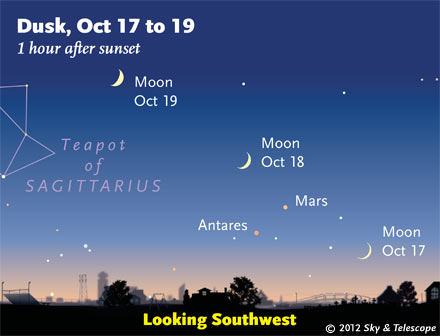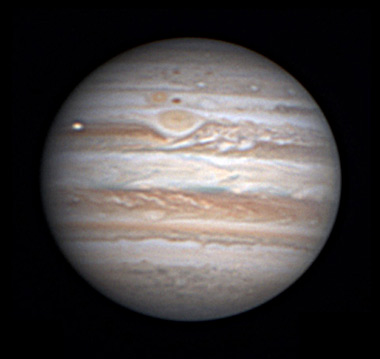
The waxing crescent Moon is passing the Mars-Antares pairup. The visibility of faint objects in bright twilight is exaggerated here. (These scenes are drawn for the middle of North America. European observers: move each Moon symbol a quarter of the way toward the one for the previous date.)
Sky & Telescope diagram
Friday, Oct. 12
Saturday, Oct. 13
Sunday, October 14
Monday, October 15
Tuesday, October 16
Wednesday, October 17
Totally invisible between them is NASA's Dawn spacecraft, which left Vesta earlier this year and will arrive at Ceres in February 2015.
Thursday, October 18
Friday, October 19
Saturday, October 20
Want to become a better amateur astronomer? Learn your way around the constellations. They're the key to locating everything fainter and deeper to hunt with binoculars or a telescope.
For an easy-to-use constellation guide covering the whole evening sky, use the big monthly map in the center of each issue of Sky & Telescope, the essential guide to astronomy. Or download our free Getting Started in Astronomy booklet (which only has bimonthly maps).
Sky Atlas 2000.0 (the color Deluxe Edition is shown here) plots 81,312 stars to magnitude 8.5. That includes most of the stars that you can see in a good finderscope, and typically one or two stars that will fall within a 50× telescope's field of view wherever you point. About 2,700 deep-sky objects to hunt are plotted among the stars.
Alan MacRobert
Once you get a telescope, to put it to good use you'll need a detailed, large-scale sky atlas (set of charts). The standards are the little Pocket Sky Atlas, which shows stars to magnitude 7.6; the larger and deeper Sky Atlas 2000.0 (stars to magnitude 8.5); and the even larger Uranometria 2000.0 (stars to magnitude 9.75). And read how to use sky charts with a telescope effectively.
You'll also want a good deep-sky guidebook, such as Sue French's Deep-Sky Wonders collection (which includes its own charts), Sky Atlas 2000.0 Companion by Strong and Sinnott, the bigger Night Sky Observer's Guide by Kepple and Sanner, or the classic if dated Burnham's Celestial Handbook.
Can a computerized telescope replace charts? Not for beginners, I don't think, and certainly not on mounts and tripods that are less than top-quality mechanically (able to point with better than 0.2° repeatability). As Terence Dickinson and Alan Dyer say in their invaluable Backyard Astronomer's Guide, "A full appreciation of the universe cannot come without developing the skills to find things in the sky and understanding how the sky works. This knowledge comes only by spending time under the stars with star maps in hand."
This Week's Planet Roundup

Jupiter's Great Red Spot had just crossed the planet's central meridian when Jim Phillips in South Carolina took this image on October 7th. South is up. Red Spot Junior (Oval BA), with a small very dark spot just behind it, has finished passing south of the Great Red Spot with no apparent effect on any of them. Intense turbulence continues on the following side of the Great Red Spot. Below center, the North Tropical Zone has rebrightened to once again separate the tan North Equatorial Belt from the North Temperate Belt. The bright point is Io.
Jim Phillips
Mercury (magnitude –0.2) is deep in the sunset. Using binoculars, try scanning for it about 30 minutes after sundown very low in the west-southwest. This will be a poor apparition of Mercury. It stays lying low there for a month, then drops back into the Sun's glare.
Venus (magnitude –4.0, in Leo) rises in darkness around 4 or 5 a.m. daylight saving time (depending on where you live), coming above the eastern horizon more than an hour before the first glimmer of dawn. By dawn it's shining brightly in the east. Look increasingly far above it for Regulus this week, as shown at the top of this page.
Mars (magnitude +1.2, in Scorpius) remains low in the southwest in evening twilight, close to twinklier orange Antares ("Anti-Mars") to its left or lower left. The gap between them shrinks from 7° to 3½° this week. They're nearly the same brightness.
Jupiter (magnitude –2.6, in Taurus) rises in the east-northeast around 9 p.m. daylight saving time. Once it's clear of the horizon, look for fainter orange Aldebaran twinkling 7½° to its right and Beta Tauri (Elnath) a little farther to Jupiter's left. By dawn this lineup-of-three stands high and vertical in the southwest.
Saturn is lost in the sunset.
Uranus (magnitude 5.7, at the Pisces-Cetus border) and Neptune (magnitude 7.8, in Aquarius) are in the southeast to south during evening. Finder charts for Uranus and Neptune.
All descriptions that relate to your horizon — including the words up, down, right, and left — are written for the world's mid-northern latitudes. Descriptions that also depend on longitude (mainly Moon positions) are for North America. Eastern Daylight Time (EDT) equals Universal Time (also known as UT, UTC, or GMT) minus 4 hours.
Like This Week's Sky at a Glance? Watch our weekly SkyWeek TV short. It's also playing on PBS!
To be sure to get the current Sky at a Glance, bookmark this URL:
http://SkyandTelescope.com/observing/ataglance?1=1
If pictures fail to load, refresh the page. If they still fail to load, change the 1 at the end of the URL to any other character and try again.
 0
0
Comments
You must be logged in to post a comment.